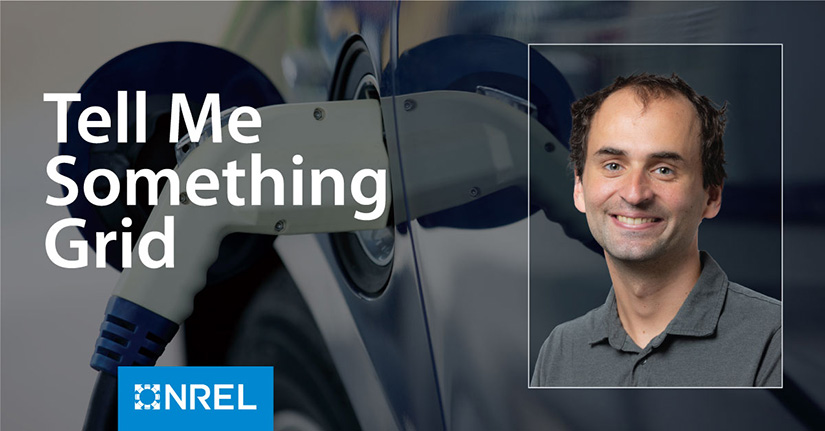Sign up for daily news updates from CleanTechnica on email. Or follow us on Google News!
NREL Analyst Luke Lavin Discusses Pitfalls and Opportunities of Managed Charging Approaches
This installment of the National Renewable Energy Laboratory’s (NREL’s) Tell Me Something Grid series features Luke Lavin, a member of NREL’s Grid Planning and Analysis Center. Lavin discusses analysis of different approaches to electric vehicle (EV) managed charging to support the future power grid.
Distributed energy resources (DERs) like rooftop solar, EVs, and battery storage systems will play an important role in the future power grid, but coordination of these resources to benefit the grid and maximize cost savings remains imperfect.
At NREL, we see this challenge as an opportunity. We are discovering the potential of DERs to create a more cost-effective, reliable, and sustainable bulk power system. A major focus for us is the role that aggregation—or combining multiple DERs to be one large-scale resource—can play in effectively integrating them into the power grid. Through collaboration with our colleagues in the transportation sector, we explored the potential opportunities and pitfalls of managing EV charging. The study builds on NREL’s work on behind-the-meter battery aggregation and the Transportation Energy & Mobility Pathway Options (TEMPO) model’s EV adoption projections.
Treating EVs As A Group & Individually
Grid operators can use EV aggregation to collectively control the charging of large numbers of EVs. Determining how much power should flow from the grid to aggregated EVs is not as simple as adding up each individual EV’s charging capacity. This is because an EV can be plugged in but already fully charged, so it could be assigned charging from the aggregate that it cannot fulfill. This can lead to unrealistic estimates of how much charging aggregated EVs can accept. Inaccurate estimates impact the grid’s ability to meet all power demands in the most efficient and cost-effective way. So operators need a way to send charging signals that can be disaggregated to fit individual EV capabilities.
We find scaling factors can be applied to aggregated EVs to maintain desirable properties for grid interaction. Applicable scaling factors reduce the ability of vehicles to increase or decrease their charging, as well as delay the accumulation of energy in their batteries by 50%. Using this method, aggregated EVs can meet charging requests with fewer requests going unfulfilled.
Coordination For Stability, Cost-Effectiveness, & Convenience
An alternative approach to aggregating EVs into a large-scale resource is to send price signals directly to individual EVs to encourage charging when power is cheapest. However, as EV adoption grows, this approach becomes inadequate because it can lead to the same behavioral response: When all vehicles respond uniformly to the same signal, it can create new peaks that strain the grid, so coordinating charging to avoid spikes in demand becomes essential.
Managed EV charging needs to be both cost-effective and convenient to complement widespread EV adoption. While the total value of managed charging across millions of vehicles is substantial for both utilities and their customers, the individual benefit (to coordination service providers and drivers) of decreasing or delaying charging for one vehicle is relatively small—often $25 to $100 per year in our analysis. This raises the question of how many drivers will actively change their refueling behavior for the small incentive. And, if ongoing behavioral change is challenging, is there a way to inexpensively automate managed charging so people do not have to think about it? By finding ways to automate managed charging at a low cost, we could better use EVs to benefit the grid.
The Value Of Data & Future Scenarios
At NREL, we have core expertise in modeling the future electric power system to come up with plausible scenarios and potential outcomes that can empower utilities and other energy stakeholders to make good planning decisions today. (One of those tools is the demand-side grid toolkit, which harnesses decades of residential, commercial, industrial, and transportation electricity load modeling for power systems analyses.) With the future of EV adoption still unfolding, NREL remains committed to making its data and findings public to allow for more informed discussions about future scenarios.
Read more from NREL’s Tell Me Something Grid series, and sign up for NREL’s energy analysis newsletter.
By Luke Lavin, from NREL
Have a tip for CleanTechnica? Want to advertise? Want to suggest a guest for our CleanTech Talk podcast? Contact us here.
EV Obsession Daily!
I don’t like paywalls. You don’t like paywalls. Who likes paywalls? Here at CleanTechnica, we implemented a limited paywall for a while, but it always felt wrong — and it was always tough to decide what we should put behind there. In theory, your most exclusive and best content goes behind a paywall. But then fewer people read it!! So, we’ve decided to completely nix paywalls here at CleanTechnica. But…
Thank you!
Community Solar Benefits & Growth
CleanTechnica uses affiliate links. See our policy here.





